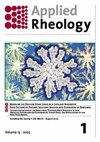固体添加剂对硝酸甘油增塑硝基纤维素流变性能的影响
IF 5.8
4区 工程技术
Q1 MECHANICS
引用次数: 1
摘要
摘要采用平行平板流变仪对硝酸甘油增塑硝化纤维素含能材料的流变特性进行了研究。采用carau - yasuda方程计算零剪切粘度,并研究了固体添加剂、温度和溶剂含量对零剪切粘度的影响。人们可以通过观察零剪切粘度来研究含能材料的流动特性,而不是观察固体添加剂、温度和溶剂含量的影响。此外,还研究了零剪切粘度与添加剂浓度的关系。采用Kissinger-Akahira-Sunose (KAS)法求出黏性流动活化能,并建立了固体添加剂浓度与黏性流动活化能的关系式。零剪切粘度(Zero-Shear Viscosity, ZSV)测试表明,温度是低溶剂含量下ZSV值的主要影响因素,随着固体添加剂浓度的增加,低溶剂含量下ZSV值降低,高溶剂含量下ZSV值升高,而石墨烯浓度大于0.1%时则相反。黏性流动活化能随固体浓度的变化趋势不同,随溶剂含量的增加而增大。利用时间-温度等效原理得到了主曲线,建立了粘度预测模型,与实验数据吻合较好,与试验结果相比,粘度预测模型在低温(15℃-25℃)下更为准确。所获得的不同方程的知识将对这种含环三甲基三胺(RDX)和石墨烯含能材料的挤压工艺研究做出贡献,本研究获得的结果对这种含能材料的挤压工艺具有一定的现实意义。本文章由计算机程序翻译,如有差异,请以英文原文为准。
Effect of Solid Additives on the Rheological Property of Nitroglycerin Plasticized Nitrocellulose
Abstract The rheological properties of energetic materials comprising nitroglycerin plasticized nitrocellulose were studied using rheological tests in a parallel plate rheometer. The Carreau-Yasuda equation was applied to calculate the zero-shear viscosity, and the dependence of solid additives, temperature and solvent content on zero-shear viscosity was developed. One can study flow characteristics of the energetic materials by observing the zero-shear viscosity instead of the effect of solid additives, temperature and solvent content. Additionally, the relationship between zero-shear viscosity and additives concentration was studied. The Kissinger-Akahira-Sunose (KAS) method was used to obtain the viscous flow activation energy, and the equation to describe the relationship between solid additives concentration and viscous flow activation energy was represented. The Zero-Shear Viscosity (ZSV) test showed that temperature was the predominant effect on the ZSV value at low solvent content, as the concentration of solid additives increased, the ZSV value decreased at low solvent content but increased at high one, however, there is an opposite trend when graphene concentration is above 0.1%. The viscous flow activation energy showed different changing trends with solid concentration that increased at different solvent content. The master curves were obtained by Time-Temperature Equivalence Principle, the viscosity prediction model has been established and showed a good agreement with the experimental data, compared with the test results, the viscosity prediction model is more accurate at low temperature (15°C-25°C). The obtained knowledge of the different equations will form a contribution to the research on extrusion process of this energetic material containing Cyclotrimethylenetrinitramine (RDX) and graphene, and the results obtained by this research have certain practical significance of the extrusion process for this energetic material.
求助全文
通过发布文献求助,成功后即可免费获取论文全文。
去求助
来源期刊

Applied Rheology
物理-力学
CiteScore
3.00
自引率
5.60%
发文量
7
审稿时长
>12 weeks
期刊介绍:
Applied Rheology is a peer-reviewed, open access, electronic journal devoted to the publication in the field of applied rheology. The journal provides the readers with free, instant, and permanent access to all content worldwide; and the authors with extensive promotion of published articles, long-time preservation, language-correction services, no space constraints and immediate publication.
 求助内容:
求助内容: 应助结果提醒方式:
应助结果提醒方式:


